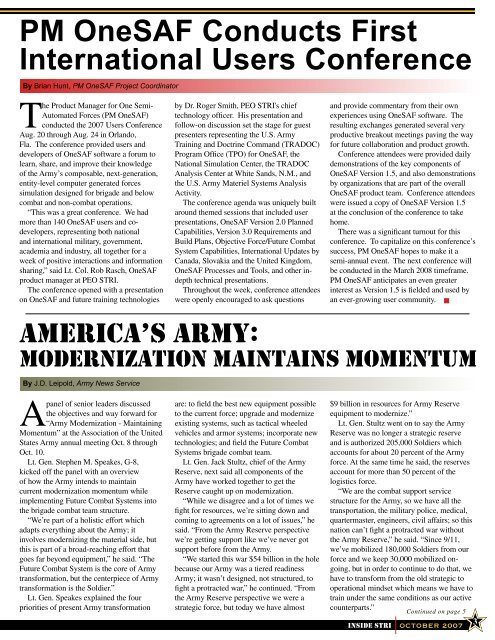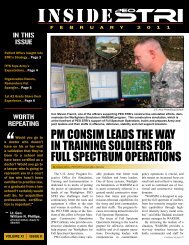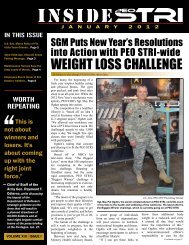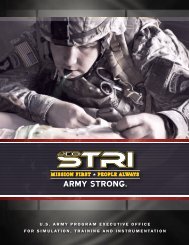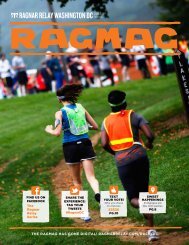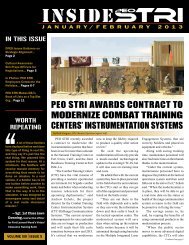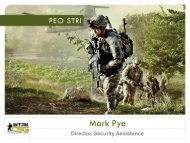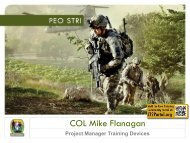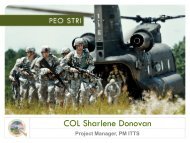inside - PEO STRI - U.S. Army
inside - PEO STRI - U.S. Army
inside - PEO STRI - U.S. Army
Create successful ePaper yourself
Turn your PDF publications into a flip-book with our unique Google optimized e-Paper software.
PM OneSAF Conducts First<br />
International Users Conference<br />
By Brian Hunt, PM OneSAF Project Coordinator<br />
The Product Manager for One Semi-<br />
Automated Forces (PM OneSAF)<br />
conducted the 2007 Users Conference<br />
Aug. 20 through Aug. 24 in Orlando,<br />
Fla. The conference provided users and<br />
developers of OneSAF software a forum to<br />
learn, share, and improve their knowledge<br />
of the <strong>Army</strong>’s composable, next-generation,<br />
entity-level computer generated forces<br />
simulation designed for brigade and below<br />
combat and non-combat operations.<br />
“This was a great conference. We had<br />
more than 140 OneSAF users and codevelopers,<br />
representing both national<br />
and international military, government,<br />
academia and industry, all together for a<br />
week of positive interactions and information<br />
sharing,” said Lt. Col. Rob Rasch, OneSAF<br />
product manager at <strong>PEO</strong> <strong>STRI</strong>.<br />
The conference opened with a presentation<br />
on OneSAF and future training technologies<br />
by Dr. Roger Smith, <strong>PEO</strong> <strong>STRI</strong>'s chief<br />
technology officer. His presentation and<br />
follow-on discussion set the stage for guest<br />
presenters representing the U.S. <strong>Army</strong><br />
Training and Doctrine Command (TRADOC)<br />
Program Office (TPO) for OneSAF, the<br />
National Simulation Center, the TRADOC<br />
Analysis Center at White Sands, N.M., and<br />
the U.S. <strong>Army</strong> Materiel Systems Analysis<br />
Activity.<br />
The conference agenda was uniquely built<br />
around themed sessions that included user<br />
presentations, OneSAF Version 2.0 Planned<br />
Capabilities, Version 3.0 Requirements and<br />
Build Plans, Objective Force/Future Combat<br />
System Capabilities, International Updates by<br />
Canada, Slovakia and the United Kingdom,<br />
OneSAF Processes and Tools, and other indepth<br />
technical presentations.<br />
Throughout the week, conference attendees<br />
were openly encouraged to ask questions<br />
and provide commentary from their own<br />
experiences using OneSAF software. The<br />
resulting exchanges generated several very<br />
productive breakout meetings paving the way<br />
for future collaboration and product growth.<br />
Conference attendees were provided daily<br />
demonstrations of the key components of<br />
OneSAF Version 1.5, and also demonstrations<br />
by organizations that are part of the overall<br />
OneSAF product team. Conference attendees<br />
were issued a copy of OneSAF Version 1.5<br />
at the conclusion of the conference to take<br />
home.<br />
There was a significant turnout for this<br />
conference. To capitalize on this conference’s<br />
success, PM OneSAF hopes to make it a<br />
semi-annual event. The next conference will<br />
be conducted in the March 2008 timeframe.<br />
PM OneSAF anticipates an even greater<br />
interest as Version 1.5 is fielded and used by<br />
an ever-growing user community.<br />
America’s <strong>Army</strong>:<br />
Modernization Maintains Momentum<br />
By J.D. Leipold, <strong>Army</strong> News Service<br />
A<br />
panel of senior leaders discussed<br />
the objectives and way forward for<br />
“<strong>Army</strong> Modernization - Maintaining<br />
Momentum” at the Association of the United<br />
States <strong>Army</strong> annual meeting Oct. 8 through<br />
Oct. 10.<br />
Lt. Gen. Stephen M. Speakes, G-8,<br />
kicked off the panel with an overview<br />
of how the <strong>Army</strong> intends to maintain<br />
current modernization momentum while<br />
implementing Future Combat Systems into<br />
the brigade combat team structure.<br />
“We’re part of a holistic effort which<br />
adapts everything about the <strong>Army</strong>; it<br />
involves modernizing the material side, but<br />
this is part of a broad-reaching effort that<br />
goes far beyond equipment,” he said. “The<br />
Future Combat System is the core of <strong>Army</strong><br />
transformation, but the centerpiece of <strong>Army</strong><br />
transformation is the Soldier.”<br />
Lt. Gen. Speakes explained the four<br />
priorities of present <strong>Army</strong> transformation<br />
are: to field the best new equipment possible<br />
to the current force; upgrade and modernize<br />
existing systems, such as tactical wheeled<br />
vehicles and armor systems; incorporate new<br />
technologies; and field the Future Combat<br />
Systems brigade combat team.<br />
Lt. Gen. Jack Stultz, chief of the <strong>Army</strong><br />
Reserve, next said all components of the<br />
<strong>Army</strong> have worked together to get the<br />
Reserve caught up on modernization.<br />
“While we disagree and a lot of times we<br />
fight for resources, we’re sitting down and<br />
coming to agreements on a lot of issues,” he<br />
said. “From the <strong>Army</strong> Reserve perspective<br />
we’re getting support like we’ve never got<br />
support before from the <strong>Army</strong>.<br />
“We started this war $54 billion in the hole<br />
because our <strong>Army</strong> was a tiered readiness<br />
<strong>Army</strong>; it wasn’t designed, not structured, to<br />
fight a protracted war,” he continued. “From<br />
the <strong>Army</strong> Reserve perspective we were a<br />
strategic force, but today we have almost<br />
$9 billion in resources for <strong>Army</strong> Reserve<br />
equipment to modernize.”<br />
Lt. Gen. Stultz went on to say the <strong>Army</strong><br />
Reserve was no longer a strategic reserve<br />
and is authorized 205,000 Soldiers which<br />
accounts for about 20 percent of the <strong>Army</strong><br />
force. At the same time he said, the reserves<br />
account for more than 50 percent of the<br />
logistics force.<br />
“We are the combat support service<br />
structure for the <strong>Army</strong>, so we have all the<br />
transportation, the military police, medical,<br />
quartermaster, engineers, civil affairs; so this<br />
nation can’t fight a protracted war without<br />
the <strong>Army</strong> Reserve,” he said. “Since 9/11,<br />
we’ve mobilized 180,000 Soldiers from our<br />
force and we keep 30,000 mobilized ongoing,<br />
but in order to continue to do that, we<br />
have to transform from the old strategic to<br />
operational mindset which means we have to<br />
train under the same conditions as our active<br />
counterparts.”<br />
Continued on page 5<br />
Inside <strong>STRI</strong> OCTOBER 2007 3


